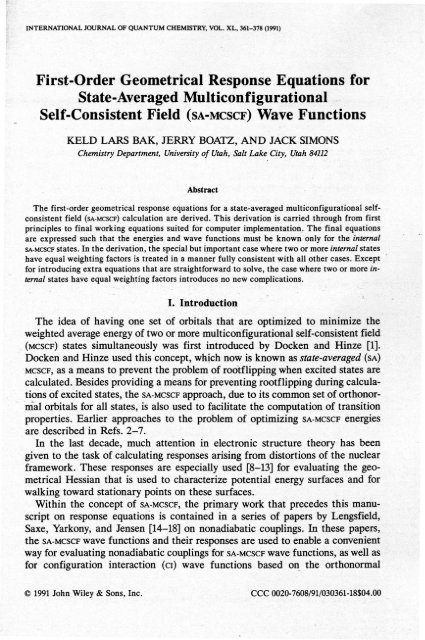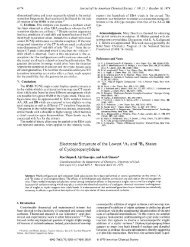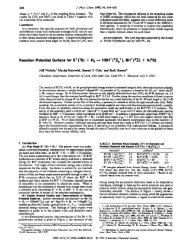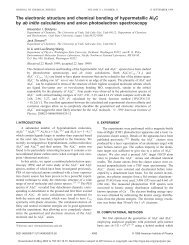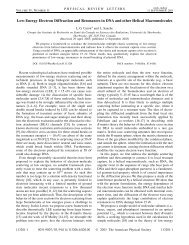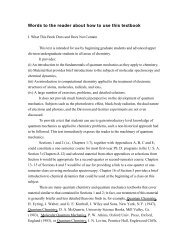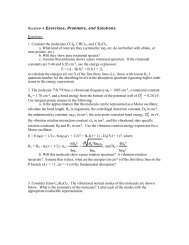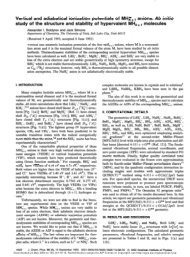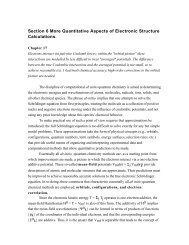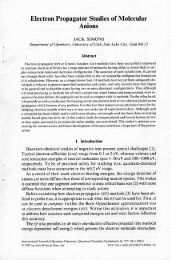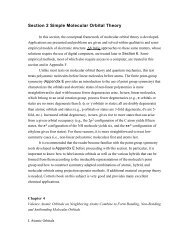First-Order Geometrical Response Equations for State ... - Jack Simons
First-Order Geometrical Response Equations for State ... - Jack Simons
First-Order Geometrical Response Equations for State ... - Jack Simons
You also want an ePaper? Increase the reach of your titles
YUMPU automatically turns print PDFs into web optimized ePapers that Google loves.
~,ti~~"INTERNATIONAL JOURNAL OF QUANTUM CHEMISTRY, VOL. XL, 361-378 (1991)<strong>First</strong>-<strong>Order</strong> <strong>Geometrical</strong> <strong>Response</strong> <strong>Equations</strong> <strong>for</strong><strong>State</strong>- Averaged MulticonfigurationalSelf-Consistent Field (SA-MCSCF)Wave FunctionsKELD LARS BAK, JERRY BOATZ, AND JACK SIMONSChemistry Department, University ol Utah, Salt Lake City, Utah 84112AbstractThe fiest-order geometrie al response equations <strong>for</strong> a state-averaged multieonfigurational selfeonsistentfield (SA.MCSCF) ealeulation ale derived. This derivation is earried through flam fiestprineiples to final working equations suited <strong>for</strong> eomputer implementation. The final equationsale expr~ssed sueh that the energies and wave funetions must be known' only <strong>for</strong> the internatSA-MCSCF states. In the derivation, the specjal but import ant ease where twa or moce internat stateshave equal weighting faetors is treated in a manner fully eonsistent wit h all other eases. Exeept<strong>for</strong> introducing extra equations that ale straight<strong>for</strong>ward to solve, the ease where twa or moce internalstates have equal weighting faetors introduees no new eomplieations.I. IntroductionThe idea of having one set of orbitais that are optimized to minimize theweighted averageenergyof iwo or more multicorifigurationalself-consistentfield,(MCSCF)states simultaneolisly was first introduced by Docken and Hinze [1].Docken and Hinze used ibis concept, which now is kROWOas state-averaged(SA)MCSCF, as a means to prevent the problemofrooiflipping when excited states arecalculated. Besidesproviding a means <strong>for</strong> preventing rootflipping during calculationsof excited states, the SA"MCSCF approach, due tDits,commonset of orthonormaiorbitais<strong>for</strong> all states, is algOused to facilitate the computation of transitionproperties. Earlier approaches to the problem of optimizing SA-MCSCF energiesare described in Refs. 2-7.In the last decade, much attention in electronic structure theory bas beengiven to the lask of calculating responses arising from distortions of the nuclearframework. These responses are especially used [8-13] <strong>for</strong> evaluating the geometricalHessian that is used to characterize potential ene~gysurfaces and <strong>for</strong>walking toward stationary pointson these surfaces.Within the concept of SA-MCSCF, the primary work that precedes ibis manuscripton response equations is contained in a series of papers by Lengsfield,Saxe, Yarkony, and Jensen [14-18]on nonadiabatic couplings. In these papers"the SA-MCSCF wave functions and their responses are used to enable a convenientwar <strong>for</strong> evaluating nonadiabatic couplings<strong>for</strong> SA.MCSCF wave functions, as well as<strong>for</strong> configuration interaction (CI)wave functions based o~ the orthonormal@ 1991 John Wiley & Song, Inc. CCC 0020-7608/91/030361-18$04.00
362 BAK, BOATZ, AND SIMONSorbitaIs tram an 'SA-MCSCF ealeulation. The theory on the response equations <strong>for</strong>SA-MCSCFealeulations published in this series of papers [14-18] is rather brief.One purpose of onr wark is to provide a moce eomprehensive derivation of thefirst-order response equations <strong>for</strong> a set of SA-MCSCFwave funetions. Onr derivationis sufficiently extensive that it is self-eontained with all expressions derivedat alevel that allows eomputer implementation. Moreover, the derivation doesnot require that aDYbut the weighted states be ealeulated. .When using SA-MCSCF as a remedy <strong>for</strong> rootflipping during ealeulatións of excitedstates, the weights used <strong>for</strong> the different wave funetions are naturally biasedsueh that the weight <strong>for</strong> the excited stale is large and weights on other statesare smalI. On the other band, when the SA-MCSCF eoneept is used to provide transitionproperties, the states <strong>for</strong> which these properties are desired are naturallyweighted equally. In the ease where twa or moce states are equally weighted, aspecjal diffieUlty oeeurs [14]. aur wark providesa eomplete derivation allowingequal weighting of twoor moce. states in a eomputationally traetable manner.SA.-MCSCF theory is c1oselyrelated to usual MCSCFtheory,which is deseribed in -a variety of notations. In thiswork, we have ehosen to use a notation similar tothat used by Hoffmann et al. [19].Part of the derivation is also paralleI to derivationsJn-[19]and a previous paper of Osamura et al. [20].aur eonventions and definitions.are stated in Seetion II. The GeneralizedBrillouin Theorem (GBT)valid <strong>for</strong> an SAealeulation is derived in Seetion III. InSection IV, quantities at infinitesimally displaeed geometries are expressed aspower series of the quantities at the undisplaeed geometries and identities arisingtram orthonormality eonstraints on the states and orbitaIs are derived. Also. in this section, the twa eondi~ions from. whieh the response equations arederived are explicitlystated. The fiest eondition relies on the GBT,and the equationsemergingtram this are derived in Section V. Similarly,the equations arisingfrom the seeond eondition are derived in Section VI. Section VII deseribes. how the response equations are naturally eombined and trans<strong>for</strong>med to a <strong>for</strong>mthat is amenable <strong>for</strong> efficient_implementation.A final diseussionof the equationsobtained is left <strong>for</strong> Section VIII, and the eonc1usionsare in Section IX.II. Conventions and DefinitionsConsider a system of atoms in an electronie spaee spanned by a set of Matomie orbital (AO),or symmetry-adaptedorbital (so), basis funetions, {XILIIL=1,2,. .., M}. From these basis funetions, a set of M orthonormal moleeular orbitals(MO'S)are ereated, {'PiIi = 1,2,..., M}, by the relationM'Pi=2: K~XIL'(1)ILwhieh defines the MOeoefficients K~., For a given symmetry, a subset of all symmetry-adapted eonfiguration-statefunetions (CSF'S)is ereated tram the MO'S,{
FIRST-ORDER GEOMETRICAL RESPONSE EQUATIONS 363The generating relation is written asVAwhere the C1's are the cI-coefficients.N= L c1l,l. In a state-averaged ca1c~lation,the N states are divided juto two sets, one. which consistsof fi so-calIedintemai states and one wh~chconsists of A so-calIedextemal stalego Note that N = fi + A. Each of the internal states is assigned a.weightingfactor tUR, which bas to be larger than zero but less than or equal toone. The weighting factors most sum to unity. The 'weighting factors are theweights of the states in the SA-MCSCF energy functional, which is defined as theweighted sum of energies ER <strong>for</strong> the set of intemai states:fifiESA == L tUR(vRIHlvR) = -L tURER.(3)RRIn this work, we assume that states and orbitaIs are real and that the- orbitaIsand internal-state cI-coefficients are variationa1ly optimized <strong>for</strong> the functiona1 inEq. (3),which also can be written as .where- .HufiESA = LtURLCfcfHu,R '11 .= L 'Yf!hii + L rfftc/(ijIki).ij iikJThe symbols 'Yf!and rfftcl.de~otethe one- and twa-particie coupling coefficients,respectively, and hii CUld(ij Iki) denote the one- and two-electron integrals; the(ij Iki) are writte~in MulIiken notation.. In line with the notationused in thissection, througn()uthis paperwe will~e .v,/.L,p,ui, j,k, I,m, n,o,pI,J,K,LA,B,DR, 5,T,UP,Qto denote AO'Sor so's," " MO'S," " CSF'S," " states in general," " internal states," " external stalegoIII. The Generalized Brillouin Theorem (GBT)<strong>for</strong> an SA-MCSCF CalculationThe purpose of this section is to derive the GBT<strong>for</strong> an SAcalculation, such thatthis theorem can be utilized in deriving the response equations.An infinitesimal variation ot the orbital 'Piwilllead to a new orbital 'Pi + 8'Pi,which ca.I1__be described in the space spanned by a1l of the orbita1s:(2)(4)(5)'Pi + 8'Pi= LOii'Pi.i(6)
364 BAK, BOATZ, AND SIMONSNowconsidering a simultaneous change of all orbitals and requiring that theyremain orthonormal, we find that the elements Oijmusi define a unitary matrix;that is, we caDwrite OijasOij = [exp(X)1j,where~1 ,= 8ij +.Xij +2 tXikXk; + ...,(7)Xii = -X;i. (8)According to Eqs. (4)-(6), the SAenergy <strong>for</strong> the set of infinitesimally variedorbitals then reads .ESA= L. - ')'tJ'L hklOikOjllJ ( .l:1 'ikl- mnop .) + ? ( r;1 L (mn IOp)Oim Ojn Oko OIP ) ,(9)where we have defined the one- and iwo-particIe SAdensity matrices as '" fiSA-~R')'ij = ~ UJR')'ij,Rfir SA- ~ r Rijkl = ~ UJR ijkl,R(lOa)(lOb)and the one- and two-particIe density matrices <strong>for</strong> each of the internai states asR - ~ l/')'ij = ~. ')'ij C1 R C/,R1/(Ha)rffkl==L rlkcfcf.lJ .(Hb)Stationary points in the orbital space (energy minima and saddle points) arecharacterized by the conditiondESAdX mn = O'(12)wherem ;c n. Using Eq. (8) to redlice the mimber of variables to the(M(M - 1)/2) independent variables (remember that M denotes the number o<strong>for</strong>bitals), the differentiation of Eq. (9) with respect to an arbitrary Xmn<strong>for</strong> m ;c ngives:d;SA = 2 L (')'~hnj - ')':ljhm;)+ 4 L (r~jkl(nj Iki) - r:ljkl(mj Iki)).dAmn ; ;kl(13)
~FIRST-ORDER GEOMETRICAL RESPONSE EQUATIONS 365To derive Eq. (13), we have exploited the following symmetries:"1ft = "Il,r~ = rtLe= rHij,kij = hji ,(ij IkI) = (ji IkI) = (kIl ji) .Now defining the SALagrangian as(14a). (14b)(14c)(14d)elf ==L "Ilthikk+ 2 L rJ,dm(ik 11m),klm(15)Eqs. (12) and (13) giveelf - elt = O, (16)which is the Generalized Brillouin Theorem <strong>for</strong> an SAca1culation, which must befulfilled <strong>for</strong> all stationary points in the orbital space.Iv. Quantities at an Infinitesimally DisplacedGeometryWe consider a situation where the internaI SA-MCSCF wave functions have beenconverged <strong>for</strong> a chosen nuclear configuration, specified by the coordinates ofeach nucleus.Then, one of these coordinates, say the a coordinate, is irifiriitesimallydistortedfrom-x to x + A.At this distorted geometry, the quantities areexpressed as power series expansions ar.oundthe same quantities of the originalnuclear configuration. Denoting the coordinates at the displaced geometry byx + A, and using the convention of not explicitly writing the geometry dependence<strong>for</strong>qu'tmtities that are evaluated at the undisplaced geometry, we find tofirst order in A: .-aH/J oH(x + A)IJ= H/J+ A- + ...,iJaiJER 000E(x + A)R= ER + A- + ...,iJaA A o acJ .C(X + Ah = CI + A- + .;.,iJao . ahijh(x + A)ij = kij + ATa + .. .,(ij IkI)(xH) = (ij IkI) + AiJ(i~~kI) + ....(17a)(17b)(17c)(17d)(17e)
366 BAK, BOATZ, AND SIMONSUsing Eq. (1)and the orthonormality of the MO'Sgives the followingidentity:oKiaKjO = ~ 7(Xl'lepj) + ~ 7(ep;jXv)I' ua v ua+ Si},(18)where we have definedSij ==~Ki I' Kja(XI'IXv) vI'Voa'(19)The term.caD, of course, be expressed as alineat~ aK~X~ aa I'aKi~I' oa1'.]combination of MO'S. ~ -2X = ~ Ulepi>(20)which, <strong>for</strong> realorbitais,definesU; = ~ a;(Xl'lepj).Equation (18) caD then be compactly expressed as0= Ui} + U; + Si}'Using this notation, we caD rewrite (ahiN(aa) and rafij IkI)]/(aa) as(21)(22) -andwhereahij- ha ~(u a h U a h ),,- ij+~ kikj+ kjik,uaka(ij IkI) = (ij IkI)a + ~ (U::li(mj IkI) + U::lj(im IkI)aam+ U::lkW ImI) + U::.lWIkm»,h!'. I] == ~ K I' i K jahl'V -I'V v oa '(23a)(23b)(24a)(ij IkW == ~ K~ KtK; K~ a(JLV Ipu ).~ aaSimilady, using Eq. (2) and the orthonormality of statesgivesO- ~ ac1 CB ~C A oC!- ~- l + ~ l-.l oa l oa(24b)(25)
FIRST-ORDER GEOMETRICAL RESPONSE EQUATIONS 367Since a change of a CIvector musi be expressible in the space of all CIvectors, wehaveA N DacI = L VADCI ,aa D(26)which can be inserted in Eqo (25) to giveO = VAB + VBA. (27)Since the one- and two-particle coupling coefficients both ale independent ofnuclear geometry (as long as the nuclear framework. belongs to the point groupchosen <strong>for</strong> the calculation), using Eqs. (17c) and (26), the density matrices at thedisplaced geometry ale given to. first order in A asNl'(x + A)fJ= l'ff+ AL VRAL cfc1(l'b' + l'GI)+ ..., (28a)A IJNr(x + A)ffkl= rffkl + AL VRAL cfc1(rfftcl + rGil) + ....A II(28b)Notice that if one wishes to include distortions that reduce the symmetry of thenuclear framework, one bas to evaluate the coupling coefficients in the lowersymmetry group. In general, if all possible distortions ale required, the calcula~tion bas to be carried out without use of point-group symmetry.Now that we have evaluated how different quantities at an infinitesimally displacedgeometry ale expressed to first order in A, and have shown in Eqs. (22)and (27) how the orthonormality conditions of the orbitais and states reduce thenumberof independent variabies, we ale ready to derive the response equations<strong>for</strong> the-set of SAwave functions. To obtain these equations, ope bas to take advantageof the two conditions that must be fulfilled <strong>for</strong> converged SA-MCSCF wavefunctions at aU nuclear geometries:, ,. (A) the SA-GliTcondition expressed inEq. (16),that states that the orbitalsareoptimized in a weighted SAmanner, and(B) the CIcoefficients <strong>for</strong> each of the SA-MCSCF internat states have to be variationallyoptimized in the chosen space of CSF'S;that is,l)RBER= L cfc! BIJ,IIbas to be valid <strong>for</strong> all CIcoefficients of the internat states.(29)In the next section, we derive the equations that arise from the GBTCondition;the equations thatarise from Eq. (29) wIll be evaluated in Section VI.V. <strong>First</strong>-<strong>Order</strong> <strong>Response</strong>s Arising erom the GBTImposing the SA-GBTto be fulfilled at the infinitesimally displaced geometry,we can use Eqs. (lO), (14), (15), (17d), (17e), (23), and (28) in Eq. (16) to giveus this GBTcondition in powers of A. Collecting first-order tetms generates the
368 BAK, BOATZ, AND SIMONSequation{} NO = 6ija- 6lta + L lURL VRAL ej (TtR- TtR)R A I .wjth the new quantities defined as+ L U,M8ik6~; - 8jk6:.l;+ Yi~ - Yj~k],nk .6r ==L ht!cyjt + 2 L (ik Ilmtfltlm ,kklmTtR ==Le~ [L(YJt + yff)hik + 2L(fJtlm + ff1u,.)(ik Ilm) ].,I k. - klm -(30) .(3ta)(3tb)Yl!'nk==hinylt + 2 L {(in Ilm)f}dm + (iii nm)(fj~mIm+ f}Amk)}.(31c),The unknown variabIes in Eq; (30) are the sets of VRA and U::k.To eliminate redundantvariabIes, and at the same time guarantee that the orbitals and states atthe infinitesimally displaced geometry are orthonormaI, we use Eqs. (22) and(27) to rewnte Eq. (30) asfiA0= 6:r - 6jta + L L VRPlURLCf(TtR - TtR)R P I+ f f VRS lURL [ef(TtR- TtR) - lUs Lef{'I:J- Tf)R S>R I I]+ L L U::k[Yl!'nk- Yj~k - Y~n + Yj~n + 8ik6:.}- 8jke:.l; - 8ind;+ 8jn6~]n k
'FIRST-ORDER GEOMETRICAL RESPONSE EQUATIONS 369oota-The linear equations that result from Eq. (32) caD be written in shorthandtion asfi A fi fi..~L L AgnkU;:k+ L LA~?RPYRP+ L L A~~RSvRs = B~,,n kR(34)In accordance with the definitions in Section II, fi is the number of internatstates, and A, the number of external stalegoThe .:lis defined as the number of 'pairs of different internat states with equal weighting factors, and the notationfi :;t:.:l, appearing in the limit <strong>for</strong> the lagi sum in Eq, (34), is 'used to denote thesum S > R runoing only over S and R being internat states with unequal weightingfactors. ,In principie, Eq. (34) represents M2 equations <strong>for</strong> i and j <strong>for</strong>ming a11possiblecombinations of orbital indices. However, from the definitions in Eqs. (33), wesee thatA -n ij,nk- - - A -nji,nk,A - -12 A -l2ij,RP- - ji,RP,A -13 ij,RS - - A -I~ji,RS,B-~,=II-131,.II>(35a)(35b)(35c)(35d)that is, the number of nonredundant and nonzero equations is (M(M - 1)/2).These equations, which caD be labeled i > j, represent the first-order responseequations arising from the SA-GBT.,VI. <strong>First</strong>-<strong>Order</strong> <strong>Response</strong>s erom Requiring the Interna! <strong>State</strong>s to beVariationally OptimizedEquation (29) represents .the requirement that the, internat SA-MCSCF states bevariatibna11y optimized within the chosen CSF srace. Using 8RB = LICfcfioEq. (29) together with Eqs. (17a), (17b), (17c), and (26), this condition caD be expressedat the infinitesima11y displaced geometry in powers of A. Defining themolecular gradient elements,iEa R-- = dER da'(36)and collecting first-order terms in A, gives the fo11owingequation:E'R8RB+ (ER - EB)VRB- L CfCfdHIJ = o.IJ da(37)Using Eqs. (14a), (14b), (23a), and (23b) and the definition of HIJ in Eq. (5) toevaluate (dHIJ)/(da), we obtaindHIJ= Hu + L m; {L (l'/f + l'fl)hik + 2 L (r/hm + rf.,[lm)(ikltm) },~ ij k ~(38)
FIRST-ORDER GEOMETRICAL RESPONSE EQUATIONS 371Eq. (41) then reads:wit h the definitions:fi A .~ ~ Ai1>,nk U:lc + ~ ~Ai~.SQ VSQ = Eip,n k
372 BAK, BOATZ, AND SIMONSIn summ ary, the response equations arising from requiring the internalSA-MCSCF states to be variationally optimized are written in Eqs. (42), (44), and(46) and they represent in their totality (nA + n(n + 1)/2) equations.VII. Strategy <strong>for</strong> Solving the <strong>Response</strong> <strong>Equations</strong>in the. CSFBasisThe response equations derived in the previous sections consist of the tour- sets of linear equations given in Eqs. (34), (42), (44), and (46). The purpose ofthis section is to rewrite these equations in a maTe compact <strong>for</strong>m and to trans<strong>for</strong>mpartsof the equations such that the CI-vectors <strong>for</strong> the external states do notneed to be ca1culated.The first three sets of equations [Eqs. (34), (42), and (44)] are already derivedsuch that they are easily combined to <strong>for</strong>m one set of linear equations with asmaDYvariabies asequations. However, since the last.set [ego(46)] is the only setthat contains the. VJiselements <strong>for</strong> which the weighting factors of the internal Rand S states are equal, this set of equations also bas to be solved. In the followingtreatment, we first consider the equations that arise tram combining Eqs. (34),(42), and (44). Then, assuming that these equations have been solved, we go onand show how to solve the remaining part of the problem by treating the equationsarising tram Eq. (46). . .Ao <strong>First</strong> Part ot the <strong>Response</strong> <strong>Equations</strong>We begin by defining the following matrices and vectors:-~11 ~21+ A31+A == A21 A22 O ,A31( O A33)v==~:,( v.am )(48a)(48b)h(H(48c)where yaex and vain are thevectors of the VJipelements and the VJis elements,respectively. Whereas R and P in VJip,respectively, denote internal and externalstates, the R and S in VJisdenote interna l states with diJJerent weighting factors.The response equations represented in Eqs. (34), (42), and (44) can then compactlybe written as-- -AV = B. (49)To evaluate the A21,A22,and 82 blocks, it appears [see Eqs. (43a-c)] to be necessaryto know both the CI vectors and energies <strong>for</strong> aU external states. Thisrequirement, however, caD be removed by ma:king a suitable unitary trans<strong>for</strong>mationwith a matrix constructed from the CIvectors. Be<strong>for</strong>e per<strong>for</strong>ming the trans-
FIRST-ORDER GEOMETRlCAL RESPONSE EQUATIONS 373<strong>for</strong>mation, Eq. (49) bas to be modified by introducing extra "dummy" equations,such that the dimension of the A22block is extended to fiN x fiN and the rowdimensions of A21,vaex, and B2 ale extended to ON. In particular, by definingthe following elements:-21:::21 = ARA,nkARA,nk - { O:::22 = Ak~SBARA,SB {- l)RSl>AB(J)RZB :::2 B2RA== { ORAand the matrices:<strong>for</strong> A within the external states,<strong>for</strong> A within the internal states,<strong>for</strong> A and B both within the external states,(50a)otherwise (z is an arbitrary but nonzero constant),(50b)<strong>for</strong> A within the external states,<strong>for</strong> A within the internal states,(50c)~1l ~21+ -.A== A21 A22(A31O~~1+),A33(51a);== ~: ( vam ), "-(51b)B ~ (~),(51c)the extended set of tesponse equations can be written asAV=B. (52)The solution vector Varising from this new matrix equation can be shown tocontain the originalresponsesof Eq. (49)as wen as additionalelementsthatidentically vanish:ua = ua,v~ex= {~~::: . .vam = vam.<strong>for</strong> A within the external states,<strong>for</strong> A within the internal states,(53a)(53b)(53c)Equation(52) caDbe subjectedto a unitary trans<strong>for</strong>mation that eliminates theneed to know the CIvectors of aDYbut the internal states. To do sa, we first defiDeamatrix with elemeDtsURl,SA == l>RSc1. (54)
374 BAK, BOATZ, AND SIMONSThis matrix is easily shown to be unitary:and the larger matrix defined as= -U+U = l , (55)lmol ~ OU= O U O ,( O O lin)(56)with lmoland lin being identity matrices with the dimensions of All and A33,respectively,and,there<strong>for</strong>e, algo unitary. Note thatthis unitary matrix bas earlierbeen used by Lengsfield [5] in deriving second-order MCSCF theory <strong>for</strong> SAwavefunctions. Using the matrix' to per<strong>for</strong>m a unitary trans<strong>for</strong>mation on Eq. (52)gives'-'-""'"_.- - - - -,UAU+UV= uii.. (57)'Oefining--- -A ==UAU+,V ==UV,B ==UB,(58a)(58b)(58c). Eq. (57) readsAV = B. (59)The A matrix and the V and B vectors are naturally written in subblocks:,All A21+A= A21 A22( A31 OA31+O ,A33)(60a), V =(~:),(60b)B=(::).(60c)where the elements of the blocks are easily evaluated. Using the followingtwadefinitions,fiLII == 2:Cfcf,(6ta)RMIl ==8u - Lu,(6tb)
FIRST-ORDER GEOMETRICAL RESPONSE EQUATIONS 375which algo result in the following equation:MIJA= Lcfcf,pthe final working expressions <strong>for</strong> the elements obtained areA u - Y SA Y SA Y SA + Y SA + ~ SA ~ SA ~ SA + ~ SAij. nk - ijnk - jink - ijkn jikn UikSnj - UjkSni -UinSkj UjnSki ,(63a)(62)Ajk,nk = WRL Md.T~f- Tl~),"I .Ajk.sL = WRSSR( ~MKIMJLHIJ - MKLER + ZLKL) ,A.~~.nk= (WR - Ws) L cJ(T~f - Tl~),JA~hu = SRTSSU(WR - ws) (Es - ER),- .(63b)(63c)(63d)(63e)Bi} = L L S~HYi~n - Yj~n + SinSkf- SjnSmn k
376 BAK, BOATZ,_AND SIMONSlonging to internal states with different weighting factors. This is the CIresponsein<strong>for</strong>mation <strong>for</strong> internal-internal rotations, but only <strong>for</strong> interna l states with diftereniweighting factors. The Qnly remaining response in<strong>for</strong>mation concerns thecI-response arising flam rotations among pairs of internal states that have equalweighting factors. This remaining in<strong>for</strong>mation is gained from the second part ofthe response equations, which we naw detail.B. -Second Partol the <strong>Response</strong> <strong>Equations</strong>For nondegeneiate states, Eq. (46) caD be rewritten such that the responses <strong>for</strong>different interna l states R and S with equal weighting factors readsVNs = (Es - ERr! LCJ {- LcfHJjJ - I ..n.+ 21 LS::nT~~+ L L [Ti~ S::k + (Ti~- T~nU-:k]n k
,,'FIRST-ORDER GEOMETRICAL RESPONSE EQUATIONS 377theorbitalrotations result in a new set of CSF'Sthat is a unitary trans<strong>for</strong>mation ofthe original set of CSF'S.In the case of a complete active space (CAS)calculation,only rotations among core orbitals and valence orbitals, among core orbitals andvirtual orbitaIs, and among valence orbit,als and virtual orbitals are nonredundaRl;that is, in a CASSA-MCSCF calculation with no use of spadal symmetry, if thenumber of core orbit aIs is MCo, the number of valence orbitaIs is MVa, and thenumber of virtual orbit aIs is MVi, the linear set of nonredundant equations representedin Eq. (59) bas the dimension (MCoMVa + MCoMVi + MVaMVi) +(ON) + (0(0 - 1)/2 - ~). .Note that <strong>for</strong> an SAcalculation where all internal states have been assigned different- weighting factors, Eq. (64) vanishes and only Eq. (59) bas to be solved.This situation occurs in the special case where the SA-MCSCF calculation is a usualMCSCFcalculation (Le., in the case where we have oBly one internal stale). In thiscase, the linear response equations in Eq. (59) are similar, but not identical, tothe response equations derived <strong>for</strong> MCSCFwave functions by Osamura et al. [20]and Hoffmann et aj. [19]...The difference' is due to the way we extend the AandBmatrices to the Aand Bmatrices, which is different tram the equivalent extensionmade in Refs. 19 and 20. The most pronounced difference between theresulting sets of equations is that the molecular gradient elements E ~ appear inthe equations of Refs. 19 and 20, ~ut does not appear in the equations derived inthis wark. However, it should be mentioned thatthe molecular gradient elements<strong>for</strong> each interna! stale caD be evaluated if desired, in OUTapproach, tramthe following equation derived tram Eq. (41):E~ = LCf{ LCfHIi - 2 1 LS::nT~J I n+ L 2: [(T~~ - Ti~)U::k ~ Ti~S::k] }'n k
378 BAK, BOATZ, AND SIMONSwhere this is not true. This treatment of interna l states with equal weighting factorsresults in an extra set of equations that bas to be solved after the first set ofresponse equations bas been solved.AcknowledgmentsThis work was supported thro~gh National Science Foundation GrantCHE 881475and by The Office of Naval Research. Support was algo provided bythe-Danish Research Academy (K. L. B.).Bibliography[1] K. K. Docken and J. Hinze, J. Chem. Phys. 57; 4928 (1972).[2] K. Ruedenberg, L. M. Cheung, and S.T. Elbert, Int. J. Quantum Chem. 16, 1069 (1979).[3] C. C. J. Roothaan, J. Detrich, and D. G. Hopper, Int. J. Quantum Chem. Symp. 13, 93(1979).[4] H.-J. Werner and W. Meyer, J. Chem. Phys. 74, 5794 (1981).- [5] B. H. Lengsfield III; J. Chem. Phys. 77, 4073 (1982).[6] T. C. Chang, C. S. Hsue, P. A. Ruttink, and W. H. E. Schwartz, Chem. Phys. 93, 405 (1985).[7] P.J. Knowles and H.-J. Werner, Chem. Phys. Lett. 115, 259 (1985).[8] T. Helgaker and P. J0rgensen, Ady. Quantum Chem. 19, 183 (1988).[9] P. Pulay, Ady. Chem. Phys. 69, 241 (1987).[10] R. D. Amos, Ady. Chem. Phys. 67, 99 (1987).[11] C. J. Cerjan and W. H. Miller, J. Chem. Phys. 75, 2800 (1981).[12] J. <strong>Simons</strong>, P. J0rgensen, H. Taylor, and J. Ozment, J. Phys. Chem. 87, 2745 (1983).[13] J. Nichols, H. Taylor, P. Schmidt, and J. <strong>Simons</strong>, J. Chem. Phys. 92, 340 (1990).[14] B. H. Lengsfield III, P. Saxe, and D. R. Yarkony, J. Chem. Phys. 81, 4549 (1984).[15] P. Saxe, B. H. Lengsfield III, and D. R. Yarkony, Chem. Phys. Lett. 113, 159 (1985).[16] B. H. Lengsfield III and D. R. Yarkony, J. Chem. Phys. 84, 348 (1986).[17] P. Saxe and D. R. Yarkony, J. Chem. Phys. 86, 321 (1987). .[18] J. O. Jensen and D. R. Yarkony, J.. Chem. Phys. 89, 975 (1988).[19] M. R. Hoffmann, D. J. Fox, J. F. Gaw, Y. Osamura, Y. Yamaguchi, R. S. Grey, G. Fitzgerald,H. F. Schaefer III, P. J. Knowies, and N. C. Handy, J. Chem. Phys. 80, 2660 (1984).[20] Y. Os!lmura, Y. Yamaguchi, and H. F. Schaefer III, J. Chem. Phys. 77, 383 (1982).Received May 24, 1990Accepted <strong>for</strong> publication August 28, 1990


